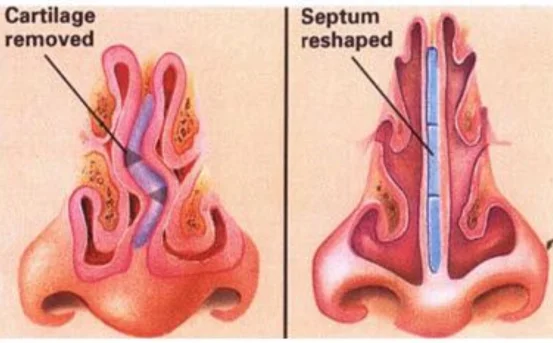Introduction
A deviated septum can significantly affect one’s quality of life leading to difficulty in breathing, chronic nasal congestion, snoring, and even frequent sinus infections. Septoplasty is a corrective surgical procedure designed to straighten a deviated nasal septum, the partition between the two nasal cavities. When medications fail to provide long-term relief, septoplasty is often considered the definitive solution. But what many people don’t realize is that septoplasty is not a one-size-fits-all surgery. Based on the severity of the deviation, the patient’s symptoms, and associated conditions, different surgical approaches may be adopted.
Here we’ll explore the different types of septoplasty surgery that ENT surgeons use to restore nasal function and improve patient well-being. Understanding the specific type of septoplasty suitable for you is a critical step in preparing for a successful surgical outcome.
Types of Septoplasty Surgery
- Traditional Septoplasty :- Traditional septoplasty is the most common and widely performed form of this surgery. It involves making an incision inside the nasal cavity to access the septum and then trimming, repositioning, or replacing parts of the bone or cartilage to straighten the structure. This technique is typically performed under local or general anesthesia, depending on the case. The surgeon lifts the mucosal lining, corrects the septal deviation, and repositions the mucosa. The procedure usually takes about 30 to 90 minutes and does not involve external scars since all work is done inside the nose. Traditional septoplasty is often chosen when the deviation is moderate to severe but does not involve complications like cosmetic deformities or nasal valve collapse. It offers a reliable and straightforward approach with a relatively short recovery time.
- Endoscopic Septoplasty :- Endoscopic septoplasty is a more advanced and minimally invasive version of the traditional method. Instead of relying solely on visual examination, this technique utilizes an endoscope a small tube fitted with a camera and light to navigate the nasal cavity with enhanced precision. This technique is especially useful for patients with difficult-to-see septal deviations or when there are coexisting problems such as sinusitis or nasal polyps. Endoscopic visualization allows for better access to deeper parts of the nasal structure, often resulting in less trauma to surrounding tissues and reduced bleeding. Endoscopic septoplasty is particularly preferred in revision surgeries or in patients with posterior septal deviations that are challenging to reach through conventional methods.
- Laser-Assisted Septoplasty :- Laser-assisted septoplasty is a newer, less commonly used technique where a laser is employed to reshape or vaporize the deformed cartilage causing the obstruction. The advantage of this method lies in its precision and minimal bleeding due to the coagulative properties of the laser. While laser septoplasty is not suitable for all types of septal deformities especially complex bony deviations it can be useful for isolated cartilage deformities or when minor reshaping is sufficient. It also has a shorter operating time and may offer a faster recovery in selected patients. However, due to equipment costs and limited applicability, this type of septoplasty is less frequently used in standard practice.
- Turbinoplasty with Septoplasty :- Sometimes a deviated septum is not the only culprit behind breathing difficulties. Enlarged turbinates structures inside the nasal passages that help humidify and filter air can also contribute to airway blockage. In such cases, turbinoplasty is performed along with septoplasty to ensure a more complete solution. This combination surgery involves reducing the size of the turbinates, either by removing part of the bone or tissue or using techniques like radiofrequency ablation. The surgeon then proceeds with the septal correction. Turbinoplasty with septoplasty is recommended when patients show signs of inferior turbinate hypertrophy along with septal deviation. The procedure may slightly extend the surgical time and recovery period, but the overall improvement in airflow and symptom relief is significantly better.
- Revision Septoplasty :- Not all septoplasties produce perfect results, and some patients may require a second surgery to address persistent or new issues. This is known as revision septoplasty. Revision procedures are generally more complex due to scar tissue, altered anatomy, or inadequate correction from the first surgery. These cases often demand a more skilled surgeon and might also require grafting techniques using cartilage from the ear or rib to rebuild nasal support. Patients who continue to experience symptoms such as nasal obstruction, postnasal drip, or sinus infections after an initial septoplasty are potential candidates for revision surgery. It’s essential to undergo thorough imaging and nasal examination before deciding on a repeat procedure.
- Septorhinoplasty :- Sometimes a deviated septum is associated with external deformities of the nose, such as a crooked nasal bridge or nasal tip asymmetry. In such cases, a more comprehensive procedure called septorhinoplasty is performed. This combines septoplasty (to correct the internal structure) with rhinoplasty (to correct the external shape of the nose). Septorhinoplasty is both a functional and cosmetic surgery. It is chosen when patients want to improve their nasal breathing and appearance in a single procedure. It is especially common in trauma cases or congenital nasal deformities. Because of its complexity, this procedure usually requires longer recovery and more meticulous post-operative care. However, it provides both aesthetic enhancement and functional improvement, making it a popular choice for patients seeking dual benefits.
Conclusion
Septoplasty is not a one-size-fits-all surgery. Depending on the individual’s nasal anatomy, severity of the deviation, and associated symptoms, different types of septoplasty are recommended. Traditional septoplasty remains the cornerstone of treatment, but newer and more advanced options such as endoscopic or laser-assisted techniques offer enhanced precision and faster recovery in selected cases.
Additionally, adjunct procedures like turbinoplasty or cosmetic corrections through septorhinoplasty can be added based on patient needs. Consulting with a qualified ENT surgeon and undergoing appropriate nasal assessments, such as imaging or endoscopy, can help determine the most suitable surgical type.
Understanding the different types of septoplasty allows patients to take a more active role in their treatment journey. Whether you’re opting for a basic correction or a more complex reconstructive surgery, the ultimate goal remains the same: improved breathing, better sleep, and a higher quality of life.























